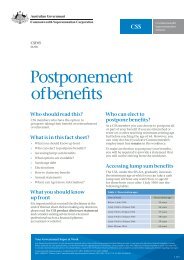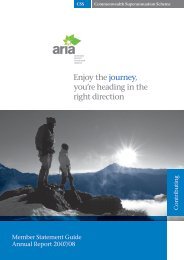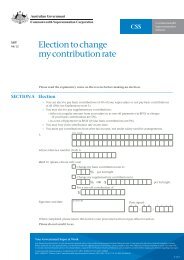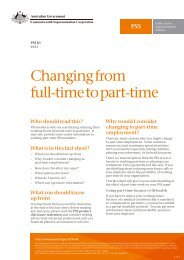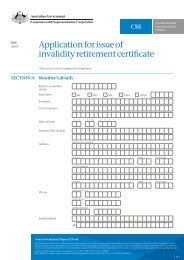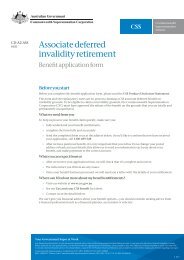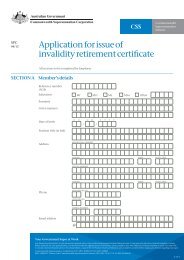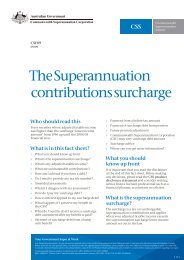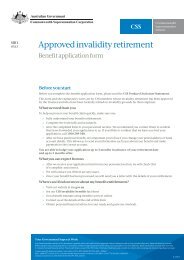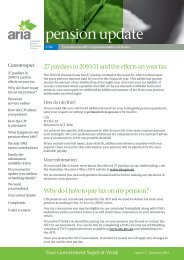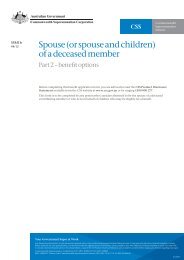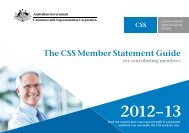Why would I considerchanging <strong>to</strong> <strong>part</strong>-<strong>time</strong>employment?There are many reasons why you might change<strong>to</strong> <strong>part</strong>-<strong>time</strong> employment. Some commonreasons include wanting <strong>to</strong> spend more <strong>time</strong>with your family (especially raising children),phasing your retirement, or for health reasons.There is a misconception that the <strong>PSS</strong> acts as abarrier <strong>to</strong> working <strong>part</strong>-<strong>time</strong> or phasing yourretirement. This is generally not the case. If youare thinking about reducing your hours, talk <strong>to</strong>your employer about the possibility of working<strong>part</strong>-<strong>time</strong> in your organisation.This fact sheet will give you an understanding ofthe effect of <strong>part</strong>-<strong>time</strong> work on your <strong>PSS</strong> super.Going <strong>part</strong>-<strong>time</strong> because of ill-healthIf you have <strong>to</strong> reduce your working hoursbecause of a medical condition that is unrelated<strong>to</strong> compensation payments, you may be entitled<strong>to</strong> a <strong>part</strong>ial invalidity pension. You can get moreinformation about <strong>part</strong>ial invalidity pensions<strong>from</strong> your employer.If you reduced your hours because of a medicalcondition and a <strong>part</strong>ial invalidity pension wasgranted, your benefit accrual would continueat the <strong>full</strong>-<strong>time</strong> rate despite the fact that yourcontributions would be at the <strong>part</strong>-<strong>time</strong> rate.How does this affectmy super?The effect on your contributionsIf you become a <strong>part</strong>-<strong>time</strong> employee there isno effect on your fortnightly contribution rateuntil your next birthday. At that <strong>time</strong>, we workout your contribution rate similarly <strong>to</strong> if youwere contributing on a <strong>full</strong>-<strong>time</strong> basis. However,your contributions would be reduced pro-rataaccording <strong>to</strong> the number of hours you areapproved <strong>to</strong> work on your birthday.ExampleMaria, a <strong>full</strong>-<strong>time</strong> employee is receiving asalary for superannuation purposes of$45,361. She is paying 7% of this incontributions <strong>to</strong> the <strong>PSS</strong>. Her contributionrate is worked out as follows:$45,361 ÷ 26 × 7% = $122.13 per fortnightMaria becomes a <strong>part</strong>-<strong>time</strong> employee andworks 50 of her normal 73.5 <strong>full</strong>-<strong>time</strong> hoursfor the position. Her contributions are workedout as follows:Step 1: Work out the <strong>full</strong>-<strong>time</strong> contribution$45,361 ÷ 26 × 7% = $122.13 per fortnightStep 2: Pro-rata the contribution according<strong>to</strong> the approved <strong>part</strong>-<strong>time</strong> hours$122.13 x 50 ÷ 73.5 = $83.08 per fortnightThe effect on my benefitThe <strong>PSS</strong> is a defined benefit scheme and benefitsare based on a number of fac<strong>to</strong>rs, including yourlength of membership, your salary and your rateof contribution.To work out your benefit, you must first work outyour Final Average Salary (FAS). This is generallythe average of your salaries on each of the threebirthdays before you leave the <strong>PSS</strong>. The salariesused are always the <strong>full</strong>-<strong>time</strong> equivalent andyour FAS will not be reduced if you were <strong>to</strong> go<strong>part</strong>-<strong>time</strong>.Then, you multiply your FAS by your benefitmultiple. Your benefit multiple accruesaccording <strong>to</strong> your rate of contribution. Yourbenefit multiple actually grows each fortnightwith each contribution you make.The following table shows the differentbenefit multiples that apply <strong>to</strong> different ratesof contribution.Contribution rateAnnual accrual rate0% .11 x FAS (or 11% of FAS)2 % .15 x FAS (or 15% of FAS)3% .17 x FAS (or 17% of FAS)4 % .19 x FAS (or 19% of FAS)5% .21 x FAS (or 21% of FAS)PSF 24 / February 20056 % .23 x FAS (or 23% of FAS)7% .25 x FAS (or 25% of FAS)8 % .27 x FAS (or 27% of FAS)9 % .29 x FAS (or 29% of FAS)10 % .31 x FAS (or 31% of FAS)2 of 3Your Government Super at Work2 of 4
So, in Maria’s case, as a <strong>full</strong>-<strong>time</strong> employee, if sheelected <strong>to</strong> pay contributions at a rate of 7% over a12-month period, her benefit multiple for a yearwould be 0.25 of her final average salary.Going <strong>part</strong>-<strong>time</strong> does not affect any benefitmultiple that you accrued while a <strong>full</strong>-<strong>time</strong>contribu<strong>to</strong>r. It may affect any future multipleaccrual though.Benefit accrual for permanent <strong>part</strong>-<strong>time</strong>employeesIf you were <strong>to</strong> go <strong>part</strong>-<strong>time</strong>, your ongoingmultiple accrual <strong>from</strong> your next birthday wouldbe reduced pro-rata according <strong>to</strong> the approvedhours worked on your next birthday. Thereduction does not apply <strong>to</strong> the multiple you hadalready accrued before your next birthday.The following formula would be used <strong>to</strong> calculateyour <strong>part</strong>-<strong>time</strong> multiple accrual:Benefit multiple x<strong>part</strong>-<strong>time</strong> hours<strong>full</strong>-<strong>time</strong> hoursTherefore, if Maria’s <strong>part</strong>-<strong>time</strong> hours (asapproved at her last birthday) were 50 hoursa fortnight, and her <strong>full</strong>-<strong>time</strong> hours for thatposition were 73.5 hours per fortnight, the yearlymultiple accrual would be:0.25 × 50 ÷ 73.5 = 0.17Calculation of benefit multipleThe following examples show the effect thatworking <strong>part</strong>-<strong>time</strong> has on the accrual of yourbenefit multiple. Maria retires after 30 years’membership. Her FAS is $45,361.In Example 1, Maria worked <strong>full</strong>-<strong>time</strong> for thelength of her membership. During this periodshe contributed 5% for 10 years, 6% for 15 yearsand 7% for five years.In Example 2, Maria worked <strong>full</strong>-<strong>time</strong> for 25years, contributing at rates of 5% for 10 years and6% for 15 years. She also worked <strong>part</strong>-<strong>time</strong> (50hours per fortnight) for five years, during which<strong>time</strong> she paid 7% in contributions.Maria’s lump sum benefit would be worked outas follows:Example 110 years × 0.21 (see table above) = 2.1015 years × 0.23 (see table above) = 3.455 years × 0.25 (see table above) = 1.25Total Benefit Multiple = 6.806.80 × $45,361 (FAS) = $308,455Example 210 years × 0.21 = 2.1015 years × 0.23 = 3.455 years (<strong>part</strong>-<strong>time</strong>) × 0.17 = 0.85Total Benefit Multiple = 6.406.40 × $45,361 (FAS) = $290,310Does going <strong>part</strong>-<strong>time</strong> affect invalidityand death benefits?In the <strong>PSS</strong>, you generally have au<strong>to</strong>maticinvalidity and death cover. In some situations,you can also purchase additional death andinvalidity cover.Your au<strong>to</strong>matic cover consists of your currentbenefit accrual plus a prospective element that iscalculated as if you had continued <strong>to</strong> contributeuntil your 60th birthday. Going <strong>part</strong>-<strong>time</strong>may reduce the prospective element of yourdeath and invalidity benefit in addition <strong>to</strong> thereduction in your ongoing accrual.What options do I have?As a <strong>part</strong>-<strong>time</strong> employee, you can elect <strong>to</strong>change your contribution rate in the same wayas you can when you are a <strong>full</strong>-<strong>time</strong> employee.However, you cannot elect <strong>to</strong> continue paying<strong>full</strong>-<strong>time</strong> contributions.If you are reducing your hours due <strong>to</strong> healthreasons, you may be entitled <strong>to</strong> a <strong>part</strong>ialinvalidity pension. You will need <strong>to</strong> talk <strong>to</strong>your personnel section <strong>to</strong> discuss this option.What do I need <strong>to</strong> do?If you would like <strong>to</strong> reduce the hours that youare working, contact your employer for moreinformation.If you do go <strong>part</strong>-<strong>time</strong>, there is nothing youwould need <strong>to</strong> do in relation <strong>to</strong> your <strong>PSS</strong> super.Your employer will provide details of your<strong>part</strong>-<strong>time</strong> hours and we will au<strong>to</strong>maticallyreduce your contributions <strong>from</strong> your nextbirthday provided that you are still working<strong>part</strong>-<strong>time</strong>.As contributions would remain at the <strong>full</strong>-<strong>time</strong>rate until your next birthday, you may wish<strong>to</strong> reduce your rate of contributions <strong>to</strong> giveyou a little more take home pay. Rememberthough, that any reduction in the rate of yourcontributions affects the amount of multiplethat you are accruing.Your Government Super at Work3 of 4



